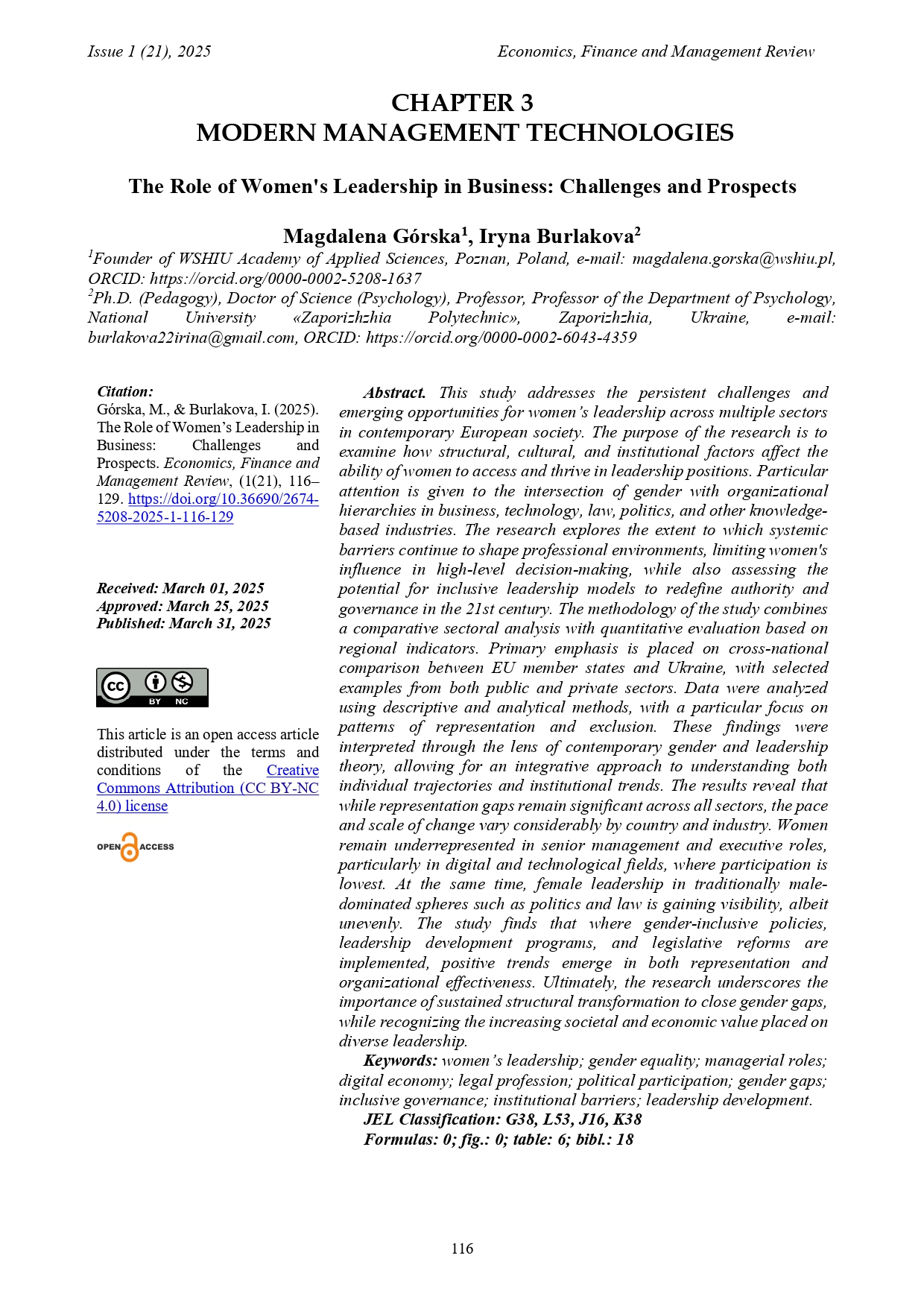THE ROLE OF WOMEN'S LEADERSHIP IN BUSINESS: CHALLENGES AND PROSPECTS
DOI:
https://doi.org/10.36690/2674-5208-2025-1-116-129Keywords:
women’s leadership, gender equality, managerial roles, digital economy, legal profession, political participation, gender gaps, inclusive governance, institutional barriers, leadership developmentAbstract
This study addresses the persistent challenges and emerging opportunities for women’s leadership across multiple sectors in contemporary European society. The purpose of the research is to examine how structural, cultural, and institutional factors affect the ability of women to access and thrive in leadership positions. Particular attention is given to the intersection of gender with organizational hierarchies in business, technology, law, politics, and other knowledge-based industries. The research explores the extent to which systemic barriers continue to shape professional environments, limiting women's influence in high-level decision-making, while also assessing the potential for inclusive leadership models to redefine authority and governance in the 21st century. The methodology of the study combines a comparative sectoral analysis with quantitative evaluation based on regional indicators. Primary emphasis is placed on cross-national comparison between EU member states and Ukraine, with selected examples from both public and private sectors. Data were analyzed using descriptive and analytical methods, with a particular focus on patterns of representation and exclusion. These findings were interpreted through the lens of contemporary gender and leadership theory, allowing for an integrative approach to understanding both individual trajectories and institutional trends. The results reveal that while representation gaps remain significant across all sectors, the pace and scale of change vary considerably by country and industry. Women remain underrepresented in senior management and executive roles, particularly in digital and technological fields, where participation is lowest. At the same time, female leadership in traditionally male-dominated spheres such as politics and law is gaining visibility, albeit unevenly. The study finds that where gender-inclusive policies, leadership development programs, and legislative reforms are implemented, positive trends emerge in both representation and organizational effectiveness. Ultimately, the research underscores the importance of sustained structural transformation to close gender gaps, while recognizing the increasing societal and economic value placed on diverse leadership.
Downloads
References
Bass, B. M., & Avolio, B. J. (1994). Improving organizational effectiveness through transformational leadership. Sage Publications.
Catalyst. (2022). Why diversity and inclusion matter: Financial performance. https://www.catalyst.org/research/why-diversity-and-inclusion-matter-financial-performance/
Crenshaw, K. (1991). Mapping the margins: Intersectionality, identity politics, and violence against women of color. Stanford Law Review, 43(6), 1241–1299. https://doi.org/10.2307/1229039
Dezsö, C. L., & Ross, D. G. (2012). Does female representation in top management improve firm performance? A panel data investigation. Strategic Management Journal, 33(9), 1072–1089. https://doi.org/10.1002/smj.1955
Eagly, A. H., & Carli, L. L. (2007). Through the labyrinth: The truth about how women become leaders. Harvard Business Press.
Eagly, A. H., Johannesen-Schmidt, M. C., & van Engen, M. L. (2003). Transformational, transactional, and laissez-faire leadership styles: A meta-analysis comparing women and men. Psychological Bulletin, 129(4), 569–591. https://doi.org/10.1037/0033-2909.129.4.569
European Commission. (2021). She figures 2021: Gender in research and innovation. Publications Office of the European Union. https://ec.europa.eu/info/publications/she-figures-2021_en
Eurostat. (2019). Women in management. https://ec.europa.eu/eurostat/statistics-explained/index.php?title=Women_in_management
Eurostat. (2022). Gender pay gap statistics. https://ec.europa.eu/eurostat/statistics-explained/index.php?title=Gender_pay_gap_statistics
Heilman, M. E. (2012). Gender stereotypes and workplace bias. Research in Organizational Behavior, 32, 113–135. https://doi.org/10.1016/j.riob.2012.11.003
International Bar Association. (2024). Gender Equality in the Legal Profession: Ukraine Report. https://www.ibanet.org
McKinsey & Company. (2020). Women in the workplace 2020. https://www.mckinsey.com/featured-insights/diversity-and-inclusion/women-in-the-workplace
Peterson Institute for International Economics. (2016). Is gender diversity profitable? Evidence from a global survey. https://www.piie.com/publications/working-papers/gender-diversity-profitable-evidence-global-survey
Ridgeway, C. L. (2011). Framed by gender: How gender inequality persists in the modern world. Oxford University Press.
UNDP. (2021). Gender equality in public administration: Ukraine case study. United Nations Development Programme. https://www.undp.org/publications/gender-equality-public-administration-ukraine
UNESCO. (2022). The gender dimensions of AI and digital skills: A global analysis. https://unesdoc.unesco.org
Women in Digital Scoreboard. (2021). Progress on women in the digital age. European Commission. https://digital-strategy.ec.europa.eu/en/library/women-digital-scoreboard
ZMINA. (2022). Gender pay gap in Ukraine. https://zmina.info

Downloads
Published
How to Cite
Issue
Section
License

This work is licensed under a Creative Commons Attribution-NonCommercial 4.0 International License.








